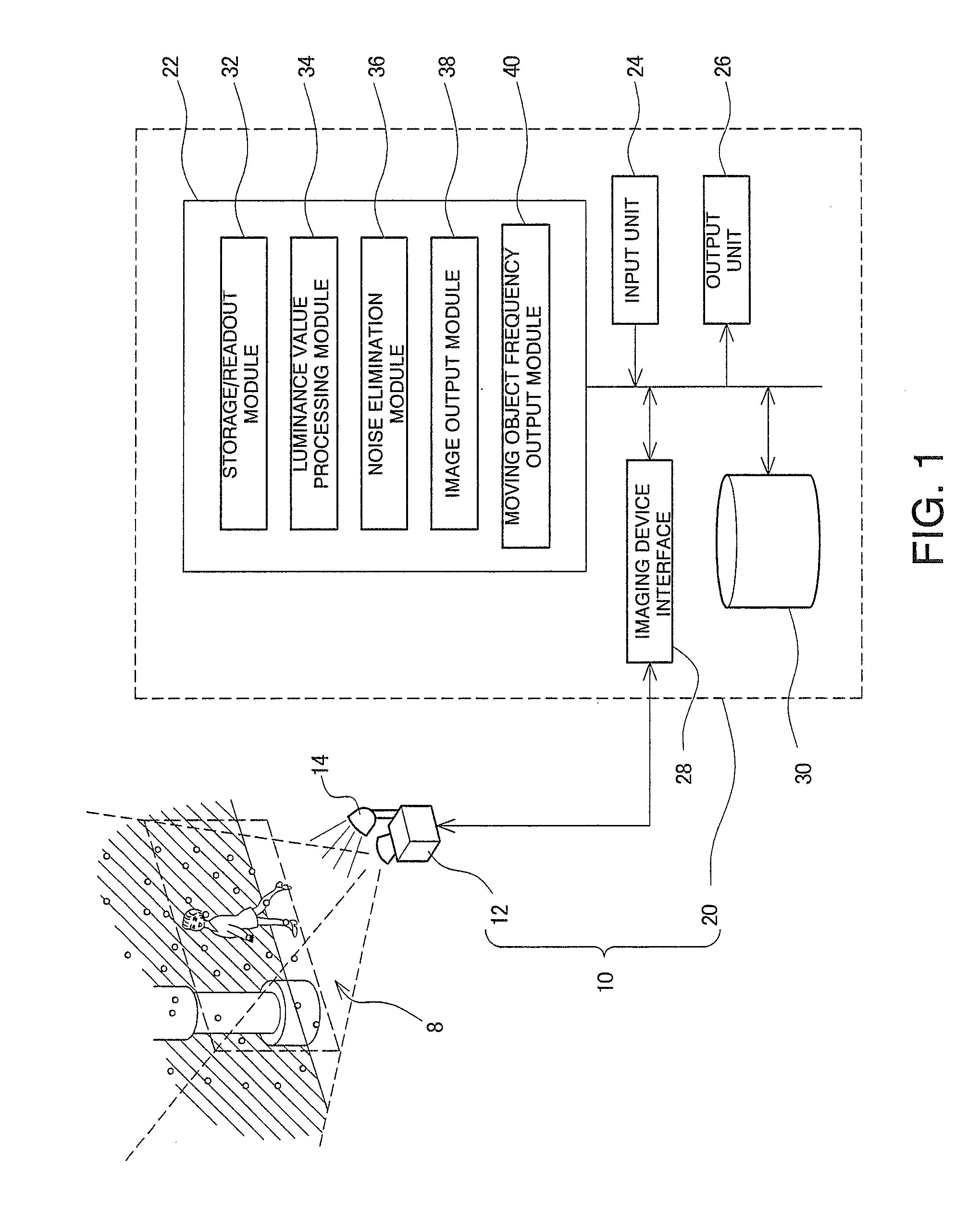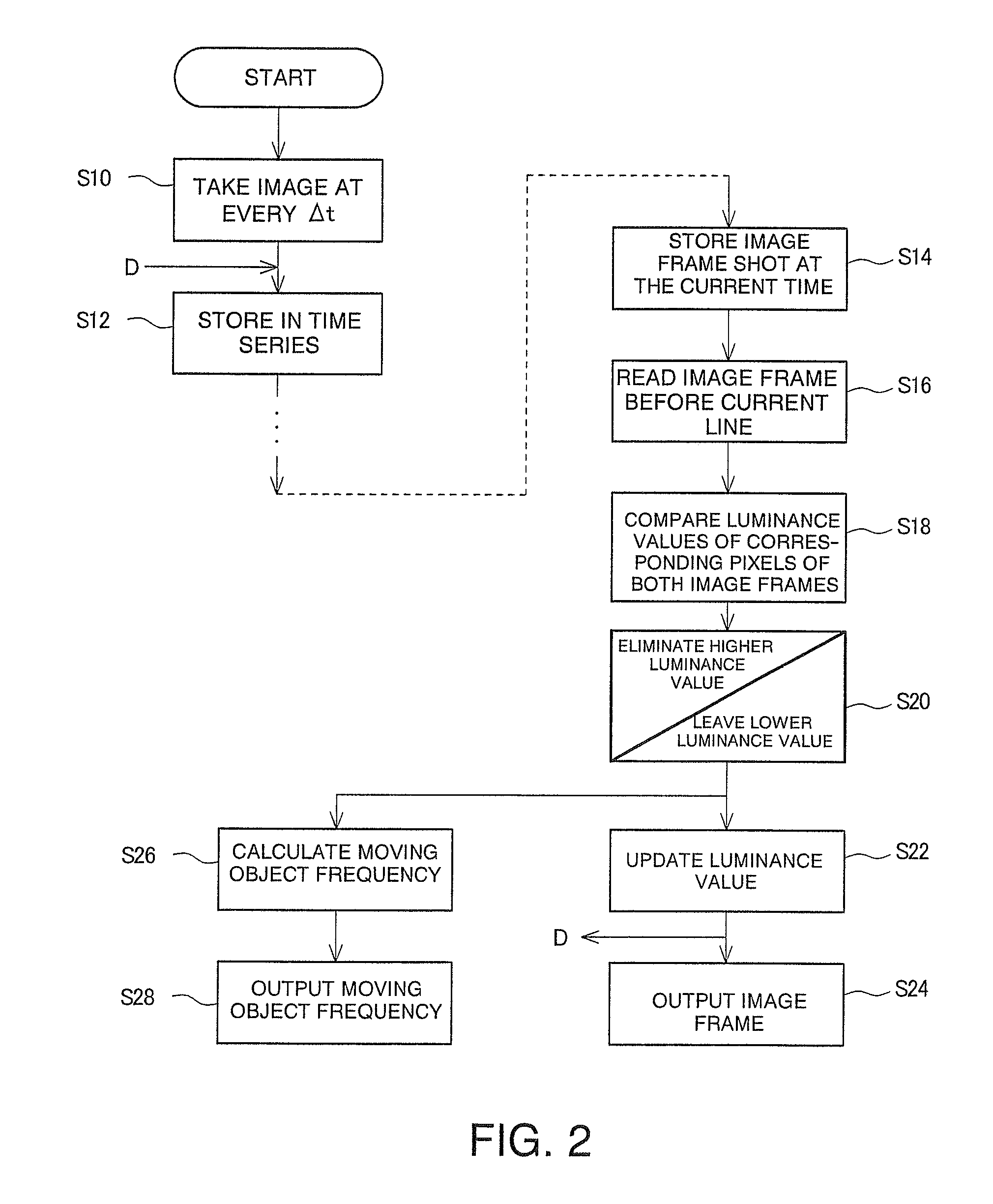Moving Object Noise Elimination Processing Device and Moving Object Noise Elimination Processing Program
a processing device and processing program technology, applied in the field of moving object noise elimination processing device and moving object noise elimination processing program, can solve the problems of insufficient monitoring from inability to detect pedestrians or obstacles in a shot image frame, and a long time is required for processing, so as to achieve the effect of eliminating moving object noise, reducing memory consumption, and increasing luminance valu
- Summary
- Abstract
- Description
- Claims
- Application Information
AI Technical Summary
Benefits of technology
Problems solved by technology
Method used
Image
Examples
first example
[0042]FIG. 1 is a diagram explaining a configuration of a moving object noise elimination processing device 10. The moving object noise elimination processing device 10 shown is mounted on a system monitoring outdoor situations. The outdoor situation monitoring system is made up of a camera 12 that is a fixed imaging device and a computer 20 that processes data shot by the camera 12 to output the data as monitored image frames. The moving object noise elimination processing device 10 is a portion of the outdoor situation monitoring system, is made up of the camera 12 and the computer 20 as hardware like the outdoor situation monitoring system, and is implemented as software by executing a moving object elimination processing program included in the monitoring program executed by the computer 20. FIG. 1 depicts a configuration of the moving object noise elimination processing device 10 in an extracted manner within the outdoor situation monitoring system.
[0043]FIG. 1 also depicts an ...
second example
[0071]Although the moving object noise is eliminated through comparison of the luminance values of the corresponding pixels in two image frames in the above description, a distribution of luminance values of corresponding pixels may be obtained in a plurality of image frames to eliminate the moving object noise based on the obtained luminance value frequency distribution.
[0072]Although the details of the luminance value processing module 34 are different in the CPU 22 of the computer 20 of FIG. 1 in this case, other constituent elements are the same as the description in association with FIG. 1. Therefore, a method of eliminating the moving object noise based on the frequency distribution of luminance values of pixels will be described with reference to a flowchart of FIG. 7 and FIG. 8. This method is implemented by software executed by the computer 20 of FIG. 1.
[0073]FIG. 7 is a flowchart of procedures for eliminating the moving object noise based on the frequency distribution of l...
third embodiment
[0086]The first and second examples are applicable when the object to be imaged is in the fixed state, in the substantially stationary state, or sufficiently greater than the moving objects (snow particles) in the outside situation 8. The substantially stationary state means that the movement speed of the object to be imaged in the screen is a sufficiently slower speed than the movement speed of the moving object in the screen, and the “slower speed” means that an object requires a longer time to pass by a certain pixel. In the case of falling snow, the falling speed does not fluctuate drastically and, for example, the outdoor snow falling speed is described as 400 mm / sec to 1000 mm / sec in Nonpatent Literature 1. Therefore, in an example when a ratio of outdoor speed is directly reflected on the screen, if the movement speed of the moving object is ½ to 1 / 10 of the snow falling speed out of doors, this speed may be defined as the substantially stationary state relative to the moving...
PUM
 Login to View More
Login to View More Abstract
Description
Claims
Application Information
 Login to View More
Login to View More - R&D
- Intellectual Property
- Life Sciences
- Materials
- Tech Scout
- Unparalleled Data Quality
- Higher Quality Content
- 60% Fewer Hallucinations
Browse by: Latest US Patents, China's latest patents, Technical Efficacy Thesaurus, Application Domain, Technology Topic, Popular Technical Reports.
© 2025 PatSnap. All rights reserved.Legal|Privacy policy|Modern Slavery Act Transparency Statement|Sitemap|About US| Contact US: help@patsnap.com



